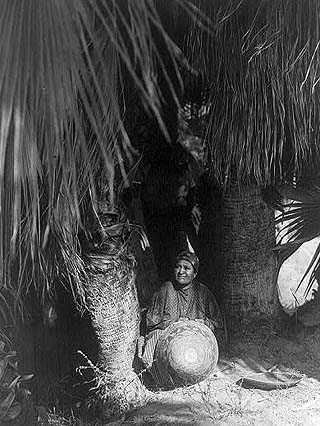History
Early History
The history of the Cahuilla in general has been told in various Bean and Vane
reports (1978; 1991; 1995; 1997), and in Bean and Mason 1960. Some history is contained
in Mukat's People (1972).
Archaeological
data suggest that they have occupied their traditional
territory in the central part of the southern California area south of the
San Bernardino Mountains
for some two thousand years.
Arrival of Europeans and Euro-Americans
The arrival of the
Spanish
and Mexicans in southern California in 1769 may have pushed them further inland and further
into the mountains. Otherwise,
they were less impacted by the Spanish intrusion than their neighbors. Few were baptized in the
coastal Spanish missions until the 1820s, when some were brought into Mission San Gabriel. Others
were baptized at a later time at the San Ysabel Asistencia (later the Franciscan Indian Mission)
established in the Santa Ysabel Valley southwest of Warner Springs by Mission San Diego, and at
the church of Our Lady of Snows, which Santa Ysabel established on Cahuilla Reservation
(Bonaventure 4/25/1945). Not much has been reported about Cahuilla involvement in the Project Area,
but it is remembered that the southern part of
Joshua Tree National Park
was within the area in
which Cahuillas from the settlements at the northern end of the Salton Sea hunted and gathered plant products.
Gold
In 1874 gold and silver was discovered in the vicinity of
Twentynine Palms,
bringing it about that
numerous
prospectors
procured themselves mining outfits and headed for the mines. A reporter for
the San Francisco Chronicle wrote about his own trip. His party left the stage road at Whitewater
and branched off to the left into the desert. Eventually it reached the Blue Jay mine. The Eagle
and the Valentine had not yet been as thoroughly prospected, he wrote. Supplies were brought in
by the Cahuilla Indians from Agua Caliente, who had "some fine ranches and now find a profitable
market for their products." It was said that the mines had been discovered by the Cahuillas. "Some of
them have some very fine specimens of gold
quartz
which they freely exhibit, but are very reticent
when questioned as to the locality in which they found it" (San Francisco Chronicle 3/7/1874).
Introduction
Material Culture, Technology
Trade, Exchange, Storage
Social Structure
Religion
History
Timeline
Traditional Territory
Major Sources

Cahuilla woman under the palms